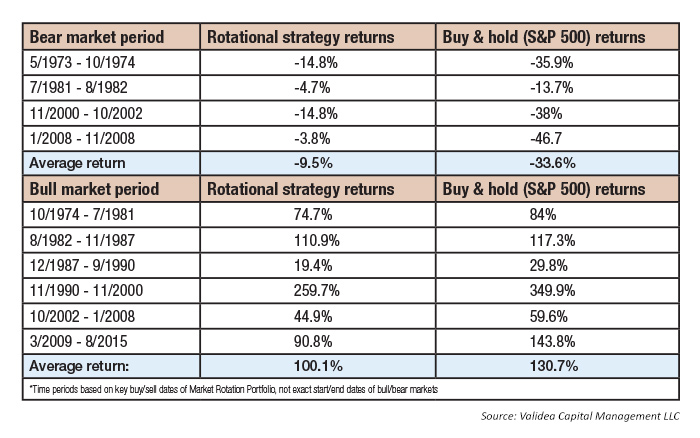
With market timing, the danger is less about the activity itself and more about how you go about it. Many market timers have little knowledge about how the market moves over time; they jump in and out of stocks or indexes based on what everyone else is doing. Their decisions are based on emotion rather than research or logic—and that usually leads to trouble. The other key challenge with a successful market-timing approach is that the timing decision is actually two independent decisions: the decision to buy stocks and the decision to sell stocks.
Market-timing tests
When I developed my active rotational approach, I looked at 16 market-timing strategies, almost all technical, and tested them back to the early 1970s. I was searching for strategies that had a long-term record of success and that made sense from a practical implementation standpoint.
The strategy that showed the best results was an asymmetrical timing model. On the sell side, the market has to close below certain key technical levels and selling needs to be accelerating, which will show up when a shorter-term moving average crosses below a longer-term moving average. The buy trigger is less stringent—it only requires the market to close above a certain shorter-term technical level. As a result, the strategy has a bias toward being in the market and not selling too quickly.
Long-term rotational model results
Backtesting shows that a disciplined investor who invested $100,000 in the S&P 500 in 1971 and then moved in and out of the market based on the strategy’s signals would have had just over $3.7 million by the end of August 2015. An investor who bought the S&P 500 on the same starting date and held the Index through that whole period would have ended up with about $2.1 million.
The strategy has worked because it gets out of stocks when a downtrend has been established and doesn’t re-enter until a significant uptrend is confirmed, so it avoids most of the major market declines. While the S&P 500 was losing 46.7% from Jan. 4, 2008, to Nov. 20, 2008, for example, an investor who used this timing strategy would have lost only 3.8%. Over the long term, avoiding those big bear-market losses can offer benefits both in terms of overall returns and peace of mind.
What’s the catch?
While this rotational strategy has yielded strong returns with low drawdowns, it isn’t perfect. Because it waits for a significant uptrend to be confirmed before buying, it may not capture a portion of the gains that occur early in a bull market—and those are often quite strong. In addition, testing shows there is a 60% chance the buy/sell signal will be wrong. The long-term data indicates it is worth it to deal with the head fakes, but seeing consecutive incorrect signals as the market advances higher can be difficult for even the most disciplined investors.
Further, the model performs exceptionally well in bear markets, but “loses” to buy-and-hold in bull markets. Though that still results in superior long-term returns, the average underperformance in bulls is greater than the average outperformance in bears. That can be a tough concept for investors to grasp, but has to do with the sequence of returns, the difficulty of making up large losses (100% gain needed to recoup a 50% loss), and the compounding effect. The net result has been total portfolio outperformance of +76% from 1971 to 2015, making it well worth the time to understand how these factors can impact a long-term investment strategy.
ROTATIONAL S&P 500 STRATEGY PERIOD RETURNS VS. BUY-AND-HOLD

 John P. Reese is co-founder of Validea Capital Management. He is the manager of Validea Capital’s active equity ETF and separate accounts. Mr. Reese is the author of “The Guru Investor: How to Beat the Market Using History’s Best Investment Strategies.” He is a graduate of MIT and Harvard Business School and holds two patents in the area of automated stock investing. Follow John’s thoughts and ideas at www.validea.com/blog or on Twitter at @guruinvestor.
John P. Reese is co-founder of Validea Capital Management. He is the manager of Validea Capital’s active equity ETF and separate accounts. Mr. Reese is the author of “The Guru Investor: How to Beat the Market Using History’s Best Investment Strategies.” He is a graduate of MIT and Harvard Business School and holds two patents in the area of automated stock investing. Follow John’s thoughts and ideas at www.validea.com/blog or on Twitter at @guruinvestor.
